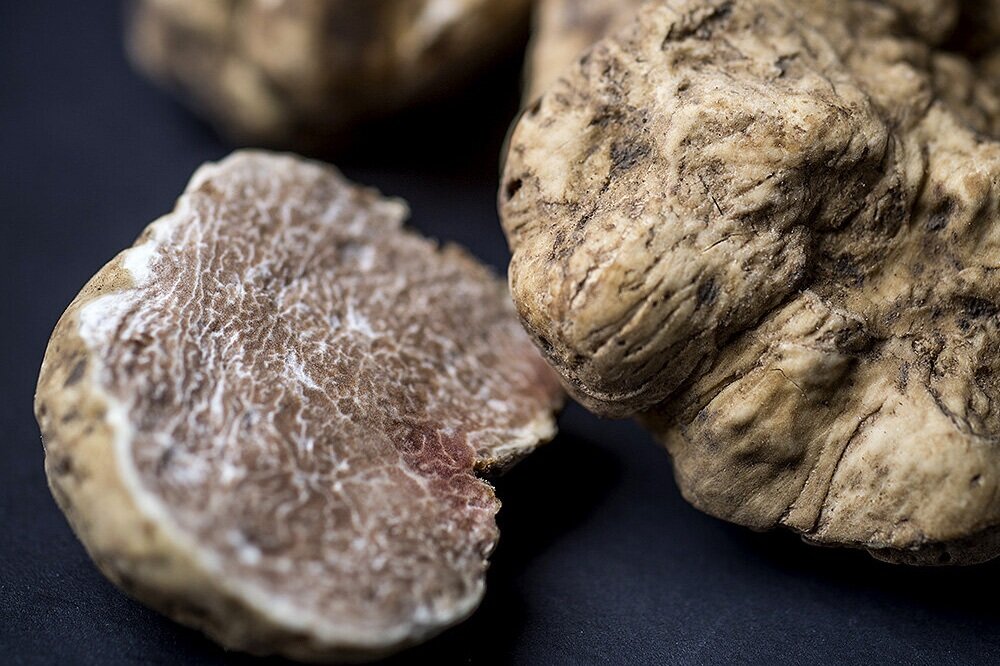What are the different varieties of truffles?
There are about sixty varieties of truffles in the world. However, only a few of them are of interest in terms of taste and some are not even edible! Around thirty species are listed in Europe. There are six so-called "gastronomic" species, the most commonly consumed for their organoleptic qualities. Five varieties of truffles are grown in France.
The Black Truffle or "Truffle of Périgord"(Tuber Melanosporum)
The Black Truffle of Périgord is without doubt the best known and most appreciated by truffle lovers for its unique and powerful aromas (dry mushroom, undergrowth, hazelnut). Of more or less rounded appearance, it is also of variable size and weight (from 5 to 10cm in diameter for 20 to 100g). Its colour ranges from grey to black with fine white veins when ripe. The Black Truffle is cultivated in the south and centre of France (Périgord, Quercy, Drôme, Lot...) but also in Italy and Spain. It is harvested from mid-November to the end of March, with a peak season from mid-January.
The White Truffle, Alba Truffle or "Piedmont Truffle"(Tuber Magnatum Pico)
The White Truffle of Alba is one of the rarest, most prestigious and therefore most expensive varieties! It is the star on the table of chefs alongside the Black Truffle. Its fragrance, very intense but fragile, is reminiscent of fresh garlic or shallots. It is easily recognisable with its smooth ecru skin and its white to brown interior , with fine white veins. The White Truffle is harvested from October to January in the northern Italian region of Piedmont. Some French truffle growers are trying to develop the cultivation in the Rhone valley.
The Summer Truffle or "Truffle of Saint John"(Tuber Aestivum)
The Summer Truffle is sometimes confused with the Black Truffle because of its relatively similar appearance. However, its flesh distinguishes it by a cream colour and more marked white veins, but less numerous. Once devalued, this variety is making a strong comeback with a renewed interest for its subtle and delicate aromas of woodland mushroom and hazelnut. Another advantage is that it is much less rare and therefore much more affordable! It is harvested from April to August.
The Burgundy Truffle or "Grey Truffle"(Tuber Uncinatum)
The Burgundy Truffle is the most widespread throughout Europe. It forms a symbiotic relationship with a large number of tree varieties (pine, hornbeam, oak, hazel, etc.) and its development is less dependent on environmental factors. With a slightly more pronounced scent than the Summer Truffle, it is more or less similar to the Melanosporum, with a dominant mushroom and hazelnut flavour. Naturally present in Burgundy and Alsace, it is also cultivated in the south and is harvested from September to the end of January.
The Brumale Truffle or 'Musk Truffle'(Tuber Brumale)
The Brumale Truffle can also be confused with the Black Truffle, which grows in the same regions and has a rather similar appearance, despite its lighter flesh. However, its fragrance is less subtle than the Melanosporum, with a more musky character and slightly spicy flavours. No larger than an egg, Brumale is harvested from November to March.
The Bianchetto or "White" Truffle(Tuber Borchii or Tuber Albidum Pico)
The Bianchetto truffle has similar characteristics to the Alba white truffle. Unlike the Alba white truffle, it is found throughout Europe, which explains its lower price. Small in size and yellow to ochre or brown in colour, it has an intense, garlicky , wild fragrance typical of white truffles. It is harvested from mid-January to the end of April.

